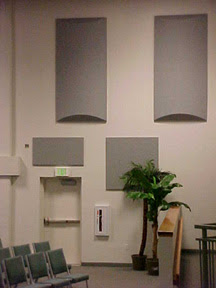» News
Church Acoustics: Reverberation in a Room
 The reverberation response of the room at different frequencies is one key measurement to examine in room acoustic design. What proper acoustic control does in a room is create a “live” feeling space while minimizing room excitement and slap-back to the platform, terms describing the effect of sound waves bouncing between the walls of a room and towards the stage. Well designed acoustical treatments will make it easy for hearers to listen, improve musician’s and vocalists’ performance space and reduce feedback, and clarify the sound picked up by the microphones to carry through to the loudspeakers.
The reverberation response of the room at different frequencies is one key measurement to examine in room acoustic design. What proper acoustic control does in a room is create a “live” feeling space while minimizing room excitement and slap-back to the platform, terms describing the effect of sound waves bouncing between the walls of a room and towards the stage. Well designed acoustical treatments will make it easy for hearers to listen, improve musician’s and vocalists’ performance space and reduce feedback, and clarify the sound picked up by the microphones to carry through to the loudspeakers.
Controlling reverb for the hearers
Acoustic control creates a good atmosphere for both musical worship and speech. Good control is making sure the spoken word is easy to hear while making sure the room is significantly lively for congregational worship. A singing congregation tends to sing more if they can hear themselves singing, thereby participating in worship. If the congregation can’t hear themselves singing, they tend to sing less; the atmosphere becomes more of a concert than worship. During speech- announcements, testimonies and sermons- it is critical to avoid ear fatigue.
Controlling reverb for the musicians and vocalists
Slap-back, long delayed reflections back onto stage, tend to muddy the sound. This makes it harder for the musicians and vocalists to hear themselves (distinguish themselves in the mix) so the stage is forced to drive louder volume levels. This sound is then jumping all over the room, creating a lot of noise that few find comfortable or appealing and musicians find frustrating.
Controlling reverb for the audio system and its engineers
The room acoustics need to work with the speaker system to keep the audio aimed on the congregation and absorb or properly disperse spill on the wall areas. The acoustics also need to help limit delayed sounds from bouncing back onto the stage and being picked up by the microphones, thus contributing to muddy sound and feedback problems. The ideal is a flat reverb where room acoustics are consistent across all frequencies (or pitch). When it comes to controlling sound, the acoustic device will be larger in size to accurately control larger frequencies (low tones) while higher frequencies (high tones) need smaller acoustic devices. Some of the room treatment will need to be fairly large, and these would be best placed on the large side walls or back walls above doors and windows. The mid to mid high frequencies are  balanced with the smaller panels. Other treatment options include clouds (larger treatments on the ceiling), sprayed on materials, different wall construction techniques and curtains or other soft goods.
balanced with the smaller panels. Other treatment options include clouds (larger treatments on the ceiling), sprayed on materials, different wall construction techniques and curtains or other soft goods.
Sometimes overlapping goals of acoustics compete. The needs of speech, instrumental music, and congregational singing require compromises in the design of the acoustic package, keeping costs under control. The solution is to design acoustic packages that balance these needs and provide a cost effective solution that improves all these areas.










» 1 Comments